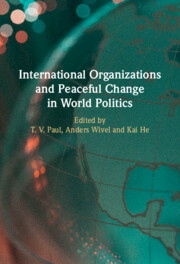Book contents
- International Organizations and Peaceful Change in World Politics
- International Organizations and Peaceful Change in World Politics
- Copyright page
- Contents
- Figures
- Tables
- Contributors
- Acknowledgments
- Part I Introduction
- Part II Theory
- Part III Practice
- 7 The UN General Assembly and Peaceful Change
- 8 Leveling Peace
- 9 Fifty Years of Advancing Peaceful Change
- 10 Reconciling Science and Politics
- 11 The “Crisis of Success” and Peaceful Change at the WTO and within the Global Trading System
- 12 International Organizations and Peaceful Change
- Part IV Conclusions
- Index
7 - The UN General Assembly and Peaceful Change
from Part III - Practice
Published online by Cambridge University Press: 30 January 2025
- International Organizations and Peaceful Change in World Politics
- International Organizations and Peaceful Change in World Politics
- Copyright page
- Contents
- Figures
- Tables
- Contributors
- Acknowledgments
- Part I Introduction
- Part II Theory
- Part III Practice
- 7 The UN General Assembly and Peaceful Change
- 8 Leveling Peace
- 9 Fifty Years of Advancing Peaceful Change
- 10 Reconciling Science and Politics
- 11 The “Crisis of Success” and Peaceful Change at the WTO and within the Global Trading System
- 12 International Organizations and Peaceful Change
- Part IV Conclusions
- Index
Summary
The UN General Assembly, a body including representatives of all UN member governments, serves as the primary forum for defining a better world order through peaceful change. It has endorsed programs of peaceful change at all levels of ambition at different times and on different issues. Much of its activity has focused on the minimalist goal of averting or ending particular wars. On other issues, most notably decolonization, national economic development, and adding environmental concerns to the intergovernmental agenda, it has contributed to incremental change in the states system. Yet the limits on what governments would endorse became clear on issues such as human rights where changes would affect domestic political orders. The end of the Cold War and related domestic-level political changes provided the context for higher ambition, which peaked in 2005 when the General Assembly endorsed the Sustainable Development Goals (SDGs). The SDGs offered a vision of deep peace in which universal respect for human rights, human development, and human security prevail within ecologically sustainable societies. Yet the subsequent spread of authoritarian rule within states and increased geopolitical tensions between major states have reinforced governments’ traditional approaches to states system, reducing the ambition of programs for peaceful change.
Keywords
- Type
- Chapter
- Information
- Publisher: Cambridge University PressPrint publication year: 2025

